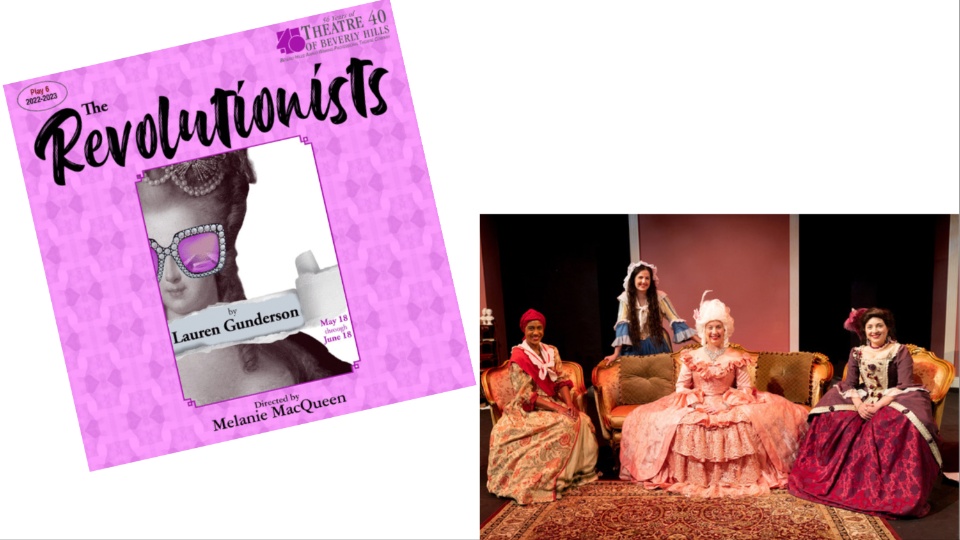
BEVERLY HILLS, Calif. — Playwright Lauren Gunderson, with 21 produced plays, is seen on stages all over the U.S. at any given time. In The Revolutionists, which debuted in Cincinnati in 2016, she looks at the position of women at the height of the French Revolution’s Reign of Terror, when the beloved guillotine was working overtime to rid the new republic of its enemies, perceived and real.
The story is told, and perhaps some of it is apocryphal, that when Richard Nixon and his entourage visited China in 1972, his consigliere Henry Kissinger, making conversation with Chou En-Lai, asked the Chinese leader what he thought of the French Revolution. The Chinese wise man (or wiseass?) reportedly answered, “It’s too soon to tell.” Ah, yes, sage, sober counsel from the 5,000-year-old Chinese civilization biding its sweet time. Or had Kissinger asked about the recent (1968) student and worker uprising in France, and in translation that came out as “French Revolution?”
Either way, the French Revolution is still contested terrain. The big picture, of course, is the overthrow of a hated, ostentatious monarchy that had outgrown its usefulness to the emerging bourgeoisie. The rising class that sought to control the levers of finance and the economy now declared its own “République.” But carried away by its democratic impulse, certain forces within the fast-changing political scene lashed out at all of the new régime’s critics, even as the Révolution fell far short of its professed ideals of Liberté, Egalité, Fraternité. During this unsettled period, many people literally lost their heads to rumor, suspicion, and the extremist insanity of Paris in 1793.

In the wake of the Révolution France did not get a safe, respectable society honoring human rights where all points of view could be confidently expressed without fear of retribution and sanction. In fact, those years following the fall of the Bastille in 1789 were wracked with fear and instability, paving the way for the emergence of a new ruler—an emperor!—in the form of Napoleon. And within a generation, by the end of the year 1815, Louis XVIII was sitting on the French throne again.
How to assess the French Revolution, then? Perhaps Chou En-Lai had in mind some of this immediate aftermath of the fall of the Bastille. It was no smooth road toward predictable bourgeois ascendancy. Had the peuple—the people so celebrated by Revolutionary propagandist Jean-Paul Marat—truly risen to power over the despised aristocracy? Or had they gone mad with fanaticism?
Perhaps a post-modern approach might work in a contemporary play about four strong and beautiful women caught up in the shifting tides of revolution. Throw a whole lot of ideas up into the air—about the efficacy of art and activism, about women’s rights, about crime and state-sanctioned terrorism, about nation and freedom and what it means to be a citizen, about sisterhood across class and rank—and see where they land.
“It’s a true story,” the play’s po-mo promo material states. “Or total fiction. Or a play about a play. Or a raucous resurrection…that ends in a song and a scaffold.”
Told in modern language with no pretense at “period” writing, yet capturing the essential meaning of the characters’ motivations, the play focuses on playwright and essayist Olympe de Gouges, struggling to put the present moment she is living in into dramatic form; the well-educated young Charlotte Corday who has resolved to assassinate Marat, the incendiary editor of the newspaper L’Ami du Peuple; Haitian rebel Marianne Angelle, sporting a red sash across her chest reading “REVOLUTION FOR ALL,” who demands an end to slavery and independence for her native land; and, somewhat incongruously, the former queen and now “Citizen Cake” Marie Antoinette, who has just lost her husband the king to the blade, and is now fearful for her own neck. (Her most famous quote, “Let them eat cake,” may never have been spoken; nevertheless, Marianne reminds her that all cake contains sugar, and all sugar comes from slave labor.)
Marianne (Alana J. Webster) wants Olympe (Kat Kemmet) to write a manifesto for Haiti and an end to slavery in the colonies. Olympe has already distinguished herself for appearing before the National Assembly to argue for equality for women and has been booed off the stage for her trouble (so much for the sweeping majesty of the “peuple” in revolutionary France!). Corday (Sami Stumman) comes to the famous feminist writer asking for a slogan or tagline she can shout upon murdering Marat (July 13, 1793) that will justify her deed and ring through the ages. As for Marie Antoinette (Meghan Lloyd), well, Madame de Gouges has already declared her objection to the Jan. 21 guillotining of King Louis XVI, in what may be among the first modern appeals to end capital punishment, so the former queen comes looking for a little sympathy and sorority for herself.
Aside from the four leading women, we see or hear three men in minor auxiliary roles (Jon Leslie, Kevin Dulude, Roger Weiss). The program also lists Ashlee Olivia as Marianne’s understudy. Melanie MacQueen directs.
I was amused, as the playwright obviously intended, by the mashup of periods and language, and by the constant reminders that we are watching a present-day conundrum about representing and remembering the past. Where I believe the play suffers is from a surfeit of self-consciousness and overwritten redundancy. I was not alone, among my theatre party of five, feeling that a good 35 minutes could well have been trimmed without any loss.

Where I did feel the loss, however, was in the foreknowledge about these characters. Marie Antoinette is of course a known quantity, portrayed here as a ditz, but still a human being, fascinated by brightly colored ribbons. Less familiar to American audiences may be Charlotte Corday, whose sole purpose in life became to rid the Révolution of Marat, one of its most fire-breathing agitators for vigilante justice. She eventually does get to utter the taut self-defense and call to action that the playwright has composed for her.
Here, Marianne, dressed as a Caribbean freedom fighter trying to get the Révolution to live up to its lofty ideals, did not as a dramatic character immediately call to my mind that other, legendary Marianne, the national personification of the French Republic since the Révolution, a kind of Goddess of Liberty portrayed in painting, sculpture, her profile appearing on the official government logo of France, on French coins and postage stamps, always depicted with her red Phrygian cap. Her closest American cousin would be Lady Liberty on the old dollar coin, or of the New York Harbor. Except that the French Marianne has a distinctly anti-aristocratic, popular, working-class essence.
As the Haitian Marianne says, “We might not know the righteousness of our cause for generations to come.” Hmmm, perhaps she’s caught a glimpse of Chou En-lai in her crystal ball.
Informational didactics about the characters in the play, taken from Wikipedia or other sources, are posted somewhat inconspicuously in the theater, but few in the audience likely noticed them.

As for Olympe de Gouges, she was indeed a real person, whom I for one did not know about—and am now glad I do. She was 45 when she died by the guillotine on Nov. 3, 1793. Aside from her plays, she authored the “Declaration of the Rights of Woman and of the [Female] Citizen,” as a retort to the “Declaration of the Rights of Man and of the [Male] Citizen,” which the National Assembly had adopted two years earlier, making her an early feminist of Mary Wollstonecraft’s generation. As noted above, she challenged other conventional views, such as on capital punishment, but also on divorce, maternity hospitals, abolitionism, and the rights of orphaned children and of unmarried mothers. It is thus not in any way inappropriate for a “play of ideas” to focus on this woman of deep thinking about social issues. Her play L’Esclavage des noirs (“Black Slavery”) had been staged at the Théâtre-Français.
In their own and various ways, all these four women sought to expand upon the promise of the French Revolution, to build on the republican principle in the abolition of the absolute monarchy, and to help write a more democratic, egalitarian, and peaceful social contract. Much is made of their “famous last words,” and Marie Antoinette’s are no exception. On the scaffold, as the executioner indicates where she should stand, she inadvertently steps on his toe. “I’m so sorry, I didn’t mean to,” she says. Her prosaic last words yet convey a stance toward the future of France, implying that she’d be content to just stay out of the way.
This adventure of words, ideas, high-flown principles—how they are conceived and how they are so horribly abused—makes for a fascinating outing at the theatre. Combining elements of absurdist theatre and morality pageant, it’s not the “well-made play” audiences may be used to, but well worth your time as an intimate dissection of this would-be “revolution within the Révolution.” As the playwright de Gouges says, as she struggles with her new drama in the opening scene, “Find the heart and not the art,” and despite its occasional longueurs, Gunderson has done just that.
If the women of The Revolutionists ask, “When will we make a revolution for ourselves?” hey, it’s a question any of us today might ask as well. The 1619 Project is certainly asking that question of the American Revolution. And one day we might have a deeper understanding about what happened—and what failed to happen—in the 1790s in France.
The stage manager is Don Solosan, and set design is by Jeff G. Rack. Costume design is by Michael Mullen, and sound design by Nick Foran. Lighting is by Derrick McDaniel, and hair/wigs by Judi Lewin.
The Revolutionists plays at Theatre 40’s Mary Levin Cutler Theatre (same venue, new name) through June 18, Thurs. through Sat. at 7:30 p.m., Sun. at 2:00 p.m. The theater is located at 241 S. Moreno Dr., Beverly Hills 90212, on the campus of Beverly Hills High School. Free parking is available in the parking lot beneath the theatre. To access parking, enter through the driveway at the intersection of Durant and Moreno Drives. For reservations call (310) 364-0535, or go the the theatre website.
We hope you appreciated this article. At People’s World, we believe news and information should be free and accessible to all, but we need your help. Our journalism is free of corporate influence and paywalls because we are totally reader-supported. Only you, our readers and supporters, make this possible. If you enjoy reading People’s World and the stories we bring you, please support our work by donating or becoming a monthly sustainer today. Thank you!












Comments